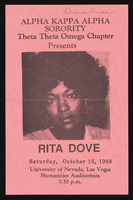Search the Special Collections and Archives Portal
Search Results
Binion’s Horseshoe Club Photograph Collection
Identifier
Abstract
The Binion’s Horseshoe Club Photograph Collection dates between approximately 1940 to 1985 and contains black-and-white and color photographic prints and negatives depicting Benny Binion’s family, friends, and Binion’s Horseshoe Club, also known as Binion’s Hotel and Casino, Binion's Horseshoe, and Binion's Gambling Hall. Photographs of Binion’s family and friends show them posed at Binion’s casino property, Binion Ranch, and events including rodeos and the Helldorado parade. Binion’s Horseshoe photographs include views of street scenes and billboard advertisements featuring Binion’s Horseshoe, the Million Dollar Display, quarter horse sales, World Series of Poker events, Binion’s Horseshoe stagecoach, and celebrities visiting the property.
Archival Collection
Pueblo Grande de Nevada Photograph Collection
Identifier
Abstract
The Pueblo Grande de Nevada Photograph Collection (approximately 1920-1980) contains black-and-white photographic prints, negatives, and slides depicting archaeological sites located in Overton, Moapa, Valley of Fire, Red Rock, Pyramid Lake, Kane Springs, Virgin River, the “Lost City,” and Lake Mead, Nevada. Images display the different stages of digging during the archaeological excavation of Pueblo Grande de Nevada. Also included are images showcasing artifacts uncovered during the excavations, the Saint Thomas, Nevada and the flooding of archaeological sites after the construction of the Hoover (Boulder) Dam.
Archival Collection
Chester Longwell Photograph Collection
Identifier
Abstract
The Chester Longwell Photograph Collection consists of 608 black-and-white photographic prints dating from approximately 1910 to 1930. The images primarily depict the Longwell family's excursions in the Southern Nevada region, primarily to Mount Charleston, Nevada. Also included are images of Southern Nevada mines and mining towns, as well as Pubelo Grande de Nevada, the Lost City. The remaining images depict geological formations and features, as well as forestry and nature scenes in Nevada and Arizona.
Archival Collection
Ed W. Clark Photograph Collection
Identifier
Abstract
The Ed W. Clark Photograph Collection contains photographs that depict politicians and businesspeople in Southern Nevada from 1900 to 1975. The photographs depict several Democratic Party members, including U.S. Senators Pat McCarran and Berkeley Bunker, Nevada Assemblyman Harry Edward "Hap" Hazard, and Nevada Governor Edward P. Carville. The photographs also depict political events, including the planting of a tree in the courthouse park of Las Vegas, Nevada, and a parade on Fremont Street in Las Vegas.
Archival Collection
Ferron and Bracken Photograph Collection
Identifier
Abstract
The Ferron and Bracken Photograph Collection depicts Southern and Central Nevada and other western states from 1890 to 1961. The photographs primarily depict the development and growth of early Las Vegas, Nevada; mines and mining operations in Southern and Central Nevada; towns and mines in Nevada; and the Hoover (Boulder) Dam and the Colorado River.
Archival Collection
John R. Moser Real Estate Appraisal Records
Identifier
Abstract
Collection contains nineteen real estate appraisal reports created by John R. Moser from Las Vegas and rural Southern Nevada (Lincoln and Nye counties) from approximately 1957 to 1972. The reports contain information on the market values of the properties and contextual information explaining the appraisals. This collection also contains photographs and photographic negatives depicting properties, and photographic slides of desert flora and landscapes around Nevada and Idaho such as Groom Mountain Range, White Bird Canyon, Salmon River Valley, Clover Valley, and Ruby Mountains.
Archival Collection
Jay Sarno Papers
Identifier
Abstract
This collection is comprised of publicity and promotional materials documenting the Caesar's Palace Hotel and Casino Resort and the Circus Circus Hotel and Casino Resort. Both resorts were a result of hotel and casino developer Jay Sarno. There is a small amount of material on Sarno in the collection such as newspaper clippings, a press release, and a copy of Sarno's FBI investigation file. The collection includes property records, magazine and newspaper clippings, informational brochures from the two properties, press kits, and a small amount of correspondence. It also includes a prospectus and stock offerings for Sarno's never-realized Grandissimo Hotel and Casino resort that would have been built on Interstate 15 to the west of the Las Vegas Strip.
Archival Collection
Minsky's Burlesque Records
Identifier
Abstract
Minsky's Burlesque Records (1922-1978) contain scripts, publicity, photographs, financial records, payroll records, sheet music, newspaper clippings, contracts, and correspondence. Also included are the personal papers of noted burlesque producer Harold Minsky, who was known for creating the "family burlesque" style of entertainment and for introducing the topless showgirl to Las Vegas, Nevada at the Dunes Hotel in 1957.
Archival Collection
McCall Family Papers
Identifier
Abstract
The McCall Family Papers are comprised primarily of family photographs and correspondence from 1910-1970. The materials concentrate on Quannah McCall and his daughter, Connie McCall, both were well known dentists in Southern Nevada. The materials also contain letters, postcards, holiday cards, and birth, death, and marriage certificates, as well as school commencement announcements for family members.
Archival Collection

Alpha Kappa Alpha Sorority, Theta Theta Omega Chapter distinguished visitor Rita Dove press release
Date
Archival Collection
Description
From the Alpha Kappa Alpha Sorority, Incorporated, Theta Theta Omega Chapter Records (MS-01014) -- Chapter records file.
Text
